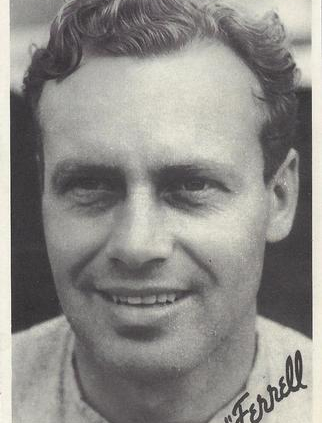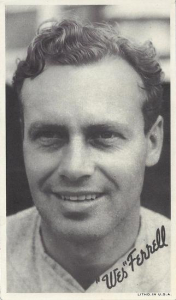July 22, 1935: Wes Ferrell hits game-winning home run to secure 15th win
Wes Ferrell is perhaps the best-hitting pitcher in baseball history. Over his 15-season major-league career, Ferrell hit .280 with 38 home runs, 57 doubles, and 12 triples.1
Ferrell put together his best season in 1935, with the Boston Red Sox. Based on the combined strength of his pitching and hitting, his 10.6 Wins Above Replacement, as calculated by Baseball-Reference, ranked first among all major leaguers.2
A July game against the lowly St. Louis Browns showcased Ferrell’s talents as he pitched nine one-run innings before hitting a walk-off home run to win the game for the Red Sox.
Born in Greensboro, North Carolina, Ferrell came up to the major leagues at age 19 with the Cleveland Indians in 1927. After spending most of 1928 in the minors, Ferrell won 102 games and posted a 3.67 ERA with Cleveland between 1929 and 1933.3 He also helped Cleveland with his bat, hitting .274 with 19 home runs in his seven seasons with the Indians.
Aside from his pitching and hitting, Ferrell was known as a temperamental competitor—for example, while pitching for Cleveland against Boston on August 30, 1932, he refused to hand the ball to manager Roger Peckinpaugh after Peckinpaugh went to the mound to remove him from the game. Peckinpaugh suspended Ferrell for 10 days without pay.4
After Ferrell held out at the start of 1934, Cleveland traded him to the Red Sox. The move reunited Ferrell with his brother, Red Sox catcher Rick Ferrell. Wes pitched well for Boston in 1934, going 14-5 with a 3.63 ERA, and earned the Opening Day start in 1935.5
The Red Sox came into a July 22 game against the Browns at 44-41. Boston had just lost three of four to the Detroit Tigers and the eventual 1935 American League MVP Hank Greenberg at Fenway Park, a series in which Ferrell had a central role in three games.6 He was the starting pitcher on July 18, when three Red Sox errors let in six unearned runs and Boston managed just five hits against Detroit’s Schoolboy Rowe. The 8-0 loss was Ferrell’s ninth defeat against 14 wins.
After Detroit, which was battling the New York Yankees for first place, took the second game of the series, Red Sox skipper Joe Cronin used Ferrell as a pinch-hitter in the bottom of the seventh in the third game. Ferrell doubled in a run to cut the lead to 5-2 and came in to pitch the eighth with Boston down by one run. Ferrell held the Tigers at bay in the eighth, but he gave up the winning run in the ninth when Goose Goslin singled in Charlie Gehringer.
The Tigers led the final game 6-4 heading to the bottom of the ninth after scoring three runs off Boston starter Lefty Grove in the top half. With Cronin and Bill Werber on base, Ferrell pinch-hit for Grove. As he strode to the plate, the Red Sox fans gave him a great ovation.7 After taking the first offering for a ball, Ferrell hit a fastball over the left-field fence to salvage the final game for Boston.8 Ferrell trotted the bases with his head down until a smile broke out as he rounded third.9
Managed by Rogers Hornsby, the Browns were off to a dismal 26-56 start that placed them at the bottom of the American League.10 The Browns’ best hitter in 1935 was outfielder Moose Solters, who had recently been acquired from the Red Sox. Hornsby’s men arrived at Fenway Park on a rare high note, having taken three of four from the Yankees.
A sparse crowd of 1,600 showed up at Fenway Park for the opener.11 Ferrell began the game by getting Browns shortstop Lyn Lary to pop out and first baseman Jack Burns to ground out. After walking Solters, Ferrell struck out Ray Pepper to end the frame.
The Browns gave the ball to Dick Coffman, a 28-year-old right-hander in his ninth big-league season. Heading into 1935, Hornsby had expressed confidence in Coffman, telling reporters “[t]here is no question about Coffman’s arm. It has all the stuff a major league pitcher needs, that is, speed and all that.”12 Coffman came into the game against Boston at 5-7 with a 4.77 ERA, having thrown 11 one-run innings in his previous start. The 1935 season would end ignominiously for Coffman: He exchanged punches with Hornsby on a train ride in early September and was sent home.13
Coffman and Ferrell traded zeroes for the first four innings. Shortstop-manager Cronin doubled to lead off the second and advanced to third on a sacrifice. But Coffman retired Werber and second baseman Dib Williams to strand Cronin. For the Browns, Lary doubled to left with one out in the third. Ferrell bore down and retired Burns and Solters to keep the game scoreless.
The Browns bunched three hits in the fifth to score a run. Second baseman Tom Carey and catcher Tommy Heath led off with singles. Coffman bunted a ball right back to Ferrell, who threw to third to force out Carey. Ferrell next retired Lary on a fly out to left fielder Roy Johnson.
With two men out and runners on first and second, Jack Burns stepped in. Burns was not a typical slugging first baseman, and even led the American League in sacrifice hits in 1935. This time Burns singled to right to score Heath and give the Browns a 1-0 lead.
Ferrell retired his former teammate Solters on a popout to second baseman Williams to end the inning. The Browns did not have a runner reach second the rest of the game.
The Red Sox tied the game in the sixth. Right fielder Dusty Cooke drew a walk to open the frame and took third on Mel Almada’s single to short center field. Cooke scored on Roy Johnson’s fly out to deep center field.
Boston looked for more when Cronin doubled—his third consecutive hit—and Rick Ferrell was intentionally walked, loading the bases with one out. But the Red Sox could not score the go-ahead run. Coffman induced a groundball from Werber to third baseman Harlond Clift, who threw home for the force out. With the bases loaded and two out, Coffman struck out Williams.
Red Sox first baseman Babe Dahlgren singled to lead off the seventh and went to second on Ferrell’s sacrifice.14 But Coffman retired Cooke and Almada. In the eighth, the Red Sox loaded the bases with one out behind two hits and a walk. Dib Williams flied out to center fielder Sam West. Roy Johnson tagged up at third and tried to score but was thrown out at home by West.
Coffman and Ferrell had dueled for eight innings, and the game was still tied, 1-1. Ferrell faced the 6-7-8 hitters in the Browns’ lineup in the ninth and retired them in order.
After Coffman retired Dahlgren on a fly out to deep center to open the ninth, he faced Ferrell. Coffman worked Ferrell to a 1-and-2 count. One of the strikes was a slow curve that Ferrell did not offer at, and the other a slow ball that Ferrell looked at.15 Seeking the strikeout, Coffman threw a letter-high curveball.16
Ferrell connected with the ball and launched a home run over the left-field wall. Solters, who was in left field, never backed up for a potential play and instead immediately walked off the field. The Boston Herald wrote that the ball crossed Lansdowne Street, beyond the wall, “where it bounded off a roof and over on to the Boston & Albany way.”17 (The Boston & Albany was a railroad that had tracks beyond Lansdowne Street.)
Ferrell circled the bases and was hugged by his teammates at home plate. It was his fifth homer of the season and his second game-winner in two days.
Said the Boston Globe, “[t]he feature [of the game] was the work of Wes Ferrell. What he did while on the mound and at bat made everybody forget the other players.”18
Ferrell finished 1935 with a 3.52 ERA and a 25-14 record in a league-leading 322⅓ innings.19 At bat, he hit seven home runs and slashed .347/.427/.533 over 179 plate appearances.20 Ferrell finished second in the American League MVP voting. The Red Sox finished in fourth place at 78-75, 16 games behind the pennant-winning Tigers.
Arm problems doomed Ferrell’s career, and his last productive season came at age 29. After his major-league career ended in 1941, he continued to mash in the minor leagues while serving as a player-manager. A credible Hall of Fame candidate, Ferrell most recently appeared on the 2013 and 2016 Pre-Integration Era ballots but received three or fewer votes both times.21
Acknowledgments
This article was fact-checked by Gary Belleville and copy-edited by Len Levin.
Sources
Besides the sources cited in the Notes, the author consulted Baseball-Reference.com and Retrosheet.org for information, including the box scores; the game descriptions in the July 23, 1935, edition of the Boston Globe, the July 22, 1935, edition of the St. Louis Post Dispatch, and the July 23, 1935, edition of the Boston Herald; and Mark Smith’s SABR BioProject biography of Wes Ferrell.
https://www.baseball-reference.com/boxes/BOS/BOS193507220.shtml
https://www.retrosheet.org/boxesetc/1935/B07220BOS1935.htm
Notes
1 Ferrell holds the major-league record for the most home runs hit while playing the position of pitcher. Players such as Babe Ruth and Shohei Ohtani hit nearly all their home runs while playing positions other than pitcher.
2 Ferrell finished first in Wins Above Replacement as calculated by FanGraphs using RA/9. Using FIP, Ferrell ranked fourth in the majors in Wins Above Replacement as calculated by FanGraphs, behind Hall of Famers Arky Vaughan, Lou Gehrig, and Jimmie Foxx.
3 In a high-scoring era, Ferrell’s ERA+ between 1929 and 1933 was 126, meaning he was 26 percent better than a league-average pitcher after adjusting for park factors.
4 “Fit of Anger Costs Wes Ferrell $1500,” Dayton Daily News, August 31, 1932: 10.
5 In the opener against the Yankees, Ferrell pitched nine scoreless innings.
6 The Tigers went on to win the pennant and the World Series.
7 Gerry Moore, “Wes Ferrell’s Pinch Homer Wins, 7 to 6,” Boston Globe, July 22, 1935: 7.
8 Moore.
9 Moore.
10 But the Browns were not off to the worst start in baseball. The Boston Braves were even worse at 21-65.
11 The Boston Globe reported that the small crowd made as much noise as 16,000.
12 Martin J. Haley, “Dick Coffman Signs, Leaving 15 of Browns Outside Fold,” St. Louis Globe-Democrat, January 27, 1935: 6.
13 “Dick Coffman and Hornsby in Fist Fight,” St. Louis Globe-Democrat, September 3, 1935: 16.
14 Four years later, on May 2, 1939, Dahlgren replaced Lou Gehrig at first base for the Yankees when Gehrig ended his streak of 2,130 consecutive games played.
15 Burt Whitman, “Ferrell Homer Wins Another,” Boston Herald, July 23, 1935: 15.
16 “Red Sox Mound Ace Ends Own Dramatic Duel With Coffman,” St. Louis Globe Democrat, July 23, 1935: 8.
17 Whitman, 1.
18 James C. O’Leary, “Wes Ferrell’s Home Run Wins Another in the Ninth,” Boston Globe, July 23, 1935: 8.
19 Ferrell’s ERA+ in 1935 was 134.
20 Ferrell’s OPS+ in 1935 was 141.
21 Wes’s brother Rick is in the Hall of Fame, selected by the Veterans Committee and inducted in 1984.
Additional Stats
Boston Red Sox 2
St. Louis Browns 1
Fenway Park
Boston, MA
Box Score + PBP:
Corrections? Additions?
If you can help us improve this game story, contact us.



